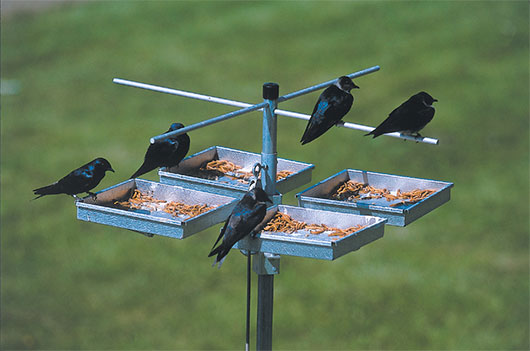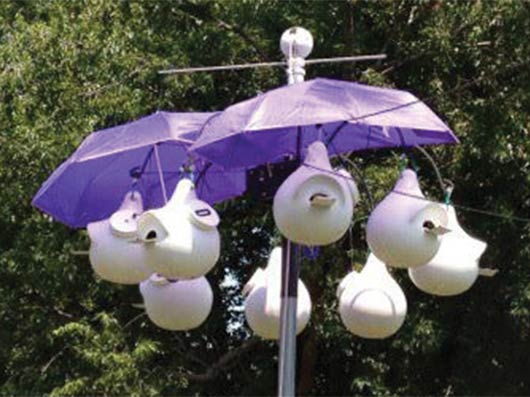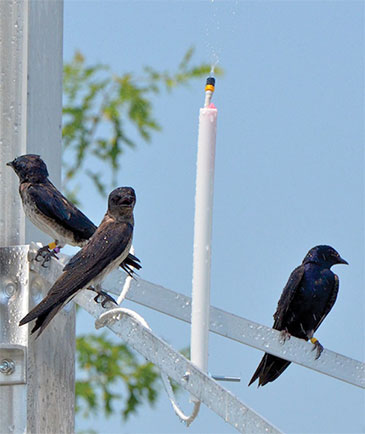Weather
Weather can play a large factor in the year-to-year success of the Purple Martin population. Since Purple Martins are aerial insectivores—meaning they catch all of their insects in flight—they are extremely vulnerable to weather conditions such as excessive cold, heat, or drought.
Cold/Wet Weather
Purple Martins are adversely affected by weather in which the temperature is constantly below about 48 degrees for three days or there is constant rain for a period longer than three days. The martins dietary staple, flying insects, do not fly in these conditions; and after the three day period martins will begin to die from starvation.
How Can You Help?
Supplemental Feeding—Although martins normally catch their insects while flying, they can be trained to accept supplemental food such as crickets, mealworms, or even scrambled eggs. Visit the Supplemental Feeding page for more information.

Heating—If you have unoccupied cavities, place a light bulb or hand warmers inside the cavity, making sure that the entrance is blocked so martins cannot enter. This will help heat the surrounding cavities.
Observation— Cold weather will also lead to "communal cavity roosting" by martins. (i.e., many birds will congregate in one nest cavity for warmth) During times of severe weather the bird closest to the entrance may die, preventing the other martins from leaving. Observe your colony site to make sure the entrances are not blocked.
Heat/Drought
Especially in southern parts of the Purple Martins’ breeding range, excessive heat and drought or prolonged high temperatures can be deadly especially for nestling martins who may be hungry and heat-stressed.
Nestling martins can tolerate temperatures up to the mid-90s (F), but when temperatures climb higher and stay there for days, landlords should take steps to shade and/or cool housing. There are a few things you can do to help protect your martins (and other cavity nesters) from heat that are fairly quick and easy. Beyond providing housing that is opaque and painted white, some of the easiest ways to offer relief to your nesters are shading, ventilation, insulation, and cooling.
A prolonged drought can affect the number of insects available. While adult Purple Martins may be able to find enough food for themselves, the nestlings may suffer. During times of prolonged heat and drought try supplemental feeding.
How Can You Help?
Shading
Purple Martin housing should be placed in an open area, and will be in the full sun all day. Installing something that helps shade the housing can offer relief from high temperatures. Look for commercial products such as shadecloth and solar screening to add lightweight shade above houses and gourd racks. Also, shade panels placed above roofs and on sunny sides of houses can offer cooling and ventilated shade.

Ventilation
Adding ventilation to housing can be done before the martin season starts. Ventilation holes can be drilled into houses, either on the back, sides, or front of the compartments. Ventilation can be added under a roof overhang, or to attic spaces. Elbow vents can be added to gourds. To keep rain out, drill vent holes from the outside and at an upward angle.
Insulation
Insulate sunny sides of housing, attics, and roof, using styrofoam board or foam insulation.

Cooling
For quick and inexpensive cooling place frozen ice packs in empty rooms adjacent to or above occupied compartments. Freeze plastic bottles of water or make slush packs using doubled zip-lock bags filled with water and small amount of rubbing alcohol. Freeze the bags, then place in empty rooms before hottest part of day. The bags stay flexible due to the alcohol. Water misters can also provide heat relief, taking care that the water does not spray into nests.
Recommended Reading:
